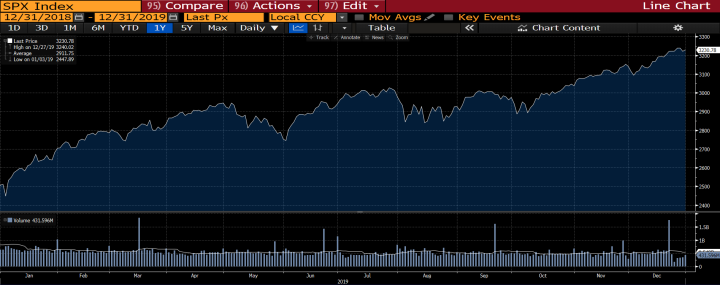
Market Update as of October 15, 2019
October 15, 2019
Coronavirus Update, Friday February 28th 2020
March 10, 2020Fluent Financial Market Update as of January 5, 2020
- “Secure Act” summary and its possible effects on your retirement
- The S&P 500 index (SPX) finished up 28.88% and the Dow Industrial Index (INDU) finished up 22.34% in 2019
- The MSCI All Country World Index (ACWI) finished up 24.05% in 2019
- The US Aggregate Bond index (AGG) finished up 8.72% in 2019
- Positive market events in 2019 include a “Dovish” Fed, a reduced impeachment threat, and positive news about China Trade, Brexit and the new NAFTA called USMCA
- Risks still exist but they are unlikely to derail the current Bull market
- Hedged portfolios trailed their benchmarks but were essential due to uncertainties within the marketplace
- We shifted slightly going into 2020 to favor Developed International holdings as well as Consumer Staples, Information Technology and Industrial names
- The generation of free cash flow using options continues to differentiate Fluent Financial from the typical mix of the stock and bond models
RETIREMENT CHANGES:
The new “Setting Every Community Up for Retirement Enhancement” or “SECURE” Act will have the greatest impact on those nearing or in retirement. This law is focused on modifying your required minimum distribution (RMD) rules and expanding retirement plan access. Several key points include:
- Required minimum distribution relief for retirement – the start date pushes back from 70 ½ to 72 allowing additional time for tax free IRA growth
- Additional Roth IRA planning opportunities – Pushing back the start date allows for an additional two years of IRA conversions
- Increased savings opportunities – allows continued tax-deductible IRA contributions after age 70 ½
- Removal of “Stretch” provisions for beneficiaries – must distribute the entire beneficiary IRA inheritance account within 10 years of the death of the owner
- Qualified birth or adoption distributions – provides for penalty-free withdrawals up to $5,000 in the case of the birth or adoption of a child which may be repaid to the plan
For additional details, please see “ 6 Ways The Secure Act May Impact Your Retirement ” from Forbes magazine
S&P 500 in 2019

MARKET SUMMARY:
It was another exciting year for investors in 2019 amid a stock market rally that saw the S&P 500 surge 28%, for the biggest gain since 2013. Easing trade tensions with China, a shift in monetary policy at the Fed, and improving economic outlook all renewed investors’ faith, while safer assets like gold and bonds also soared.
As the stock market closes 2019 with a bang, attention turns to the election year of 2020 with investors wondering if the stock market can continue the streak that has made this bull market the longest in history. It is easy to identify the headwinds at the beginning of each year; the difficult part is accurately determining if those headwinds will pose an actual threat to the rising stock market or not.
- Political Uncertainty – No one expects any surprise in the Senate impeachment trial, assuming the Articles eventually make their way there. The bigger political risk would be if one of the socialist candidates were to make it out of the Democrat primary.
- Trade – Phase 1 of the trade deal between the U.S. and China was celebrated by the markets and was largely responsible for the markets ending at highs in 2019. Halting new tariffs and a small rollback on previously implemented tariffs is certainly a positive, but very few details have emerged that both countries seem to confirm are part of an agreement.
- Record Low and Negative Interest Rates – at these record low interest rate levels, any uptick in interest rates could cause the loss of principle in fixed income assets, historically know to be a safe asset class
PORTFOLIO SUMMARY:
Our portfolios trailed their associated benchmarks in 2019 but this can be attributed to the fact that Fluent Financial was hedging against uncertainties throughout the year. Our number one priority is protecting client assets, followed by the priority of making those assets grow. Hedging will always be a double-edged sword that limits upside potential while at the same time protecting clients from large downward swings. The lack of any significant downward swings in 2019 means that the precautionary measures taken to protect our portfolios ended up being a drag on our performance as markets continued to reach record highs.
Defensive measures taken in 2019 included several Fluent Financial portfolios increasing their Put protection, increased cash levels, or in some cases, both. Several hurdles were overcome this year and any time unknowns become knowns, markets tend to react positively. These hurdles included:
- A Mid-Year Federal Reserve Policy shift favoring rate increases, now favoring rate decreases (Hawkish to Dovish)
- Impeachment probability significantly reduced after the Mueller report was released
- A phase one China deal agreed upon in principal
- The new NAFTA (USMCA) trade agreement moving forward through Congress
- BREXIT moving forward with new support for Boris Johnson in England
Recently rebalanced ETF portfolios reflected a slight policy shift from Domestic Large-Cap holdings into Developed International ETFs as we move into 2020. The major shift in our Equity portfolios was a reduction in Health Care and Materials in favor of Consumer Staples, Information Technology and Industrial names.
MOVING FORWARD:
Careful analysis of the Market Summary risks posed, and even those not mentioned: Russia, North Korea, Iran, Repo’s, etc. suggests that while these cannot be ignored, they are unlikely to derail the bull market. The most compelling reason why is the global liquidity being provided by the Central Banks. We entered 2019 with almost no Central Bank easing and enter 2020 with the most synchronized level of easing since the Great Recession in 2008; higher than the level of easing after the recession of 2000-2002. Liquidity should win this tug-o-war, allowing markets to add to gains in 2020 even if the environment becomes more volatile.
On the fixed income front, long-term returns for bonds tend to match up well with their yield to maturity. With the Federal Reserve hinting at no action, and coming off outsized returns in 2019, there are plenty of indicators that support bonds reverting to a return driven more by the income than price appreciation at historically low interest rate levels.
On the equity side, concerns of valuations creeping up are being offset by pockets of positive economic signals. That said, the story of the day tends to be outweighing stock fundamentals as the primary driver of near-term returns. This is a challenge to traditional data-driven decision making and will likely be a driver of continued bouts of short-term volatility ahead.
In a potential low return environment with no clear asset class looking particularly enticing, investors will need to take advantage of opportunities to get more out of their existing investments rather than abandoning their fortified asset allocation base. Adding more capital efficiency to a portfolio through an options strategy can provide the potential to achieve attractive returns in this environment without stretching the portfolio’s risk.
The introduction of our new STOCK INCOME portfolio in late 2019 achieves this capital efficiency described above and has been well received thus far, generating monthly cash off existing portfolio holdings. Several other portfolios continue to use an options strategy, generating additional free cash flow for our clients and differentiating ourselves from the traditional 60/40 Stock/Bond models.
Sincerely,
Mitch Kramer and the Fluent Financial Team



